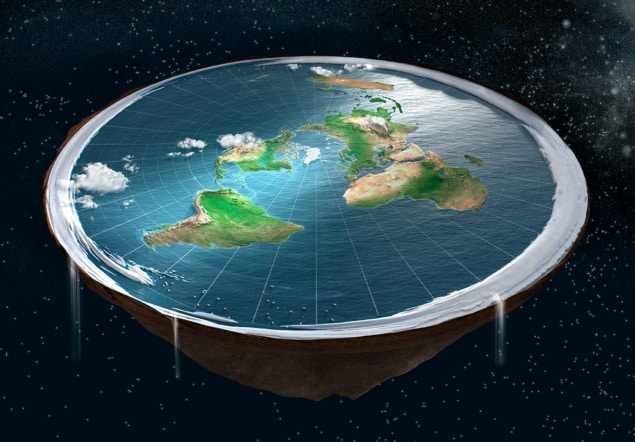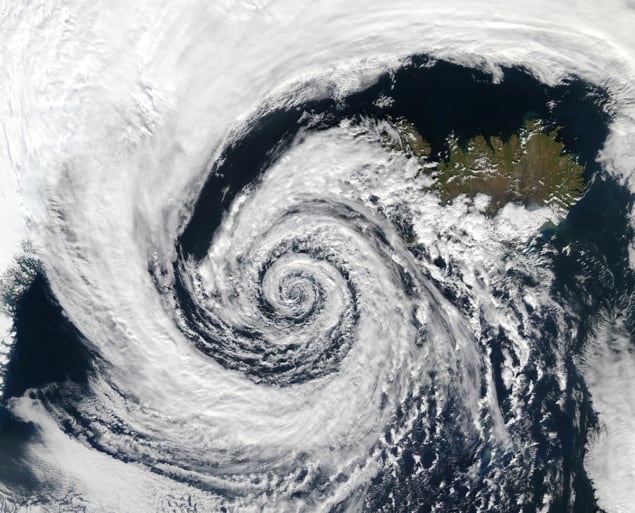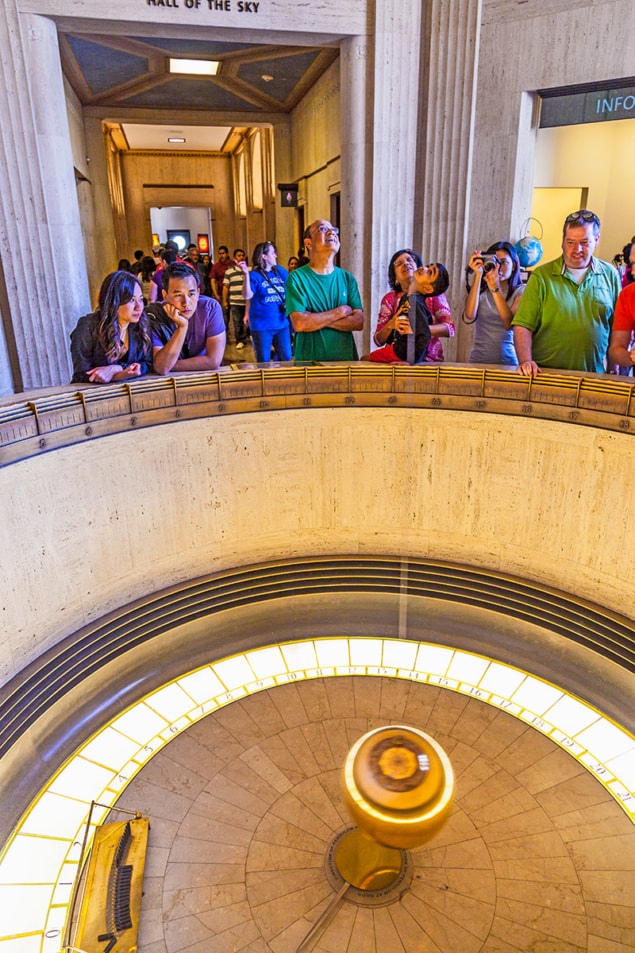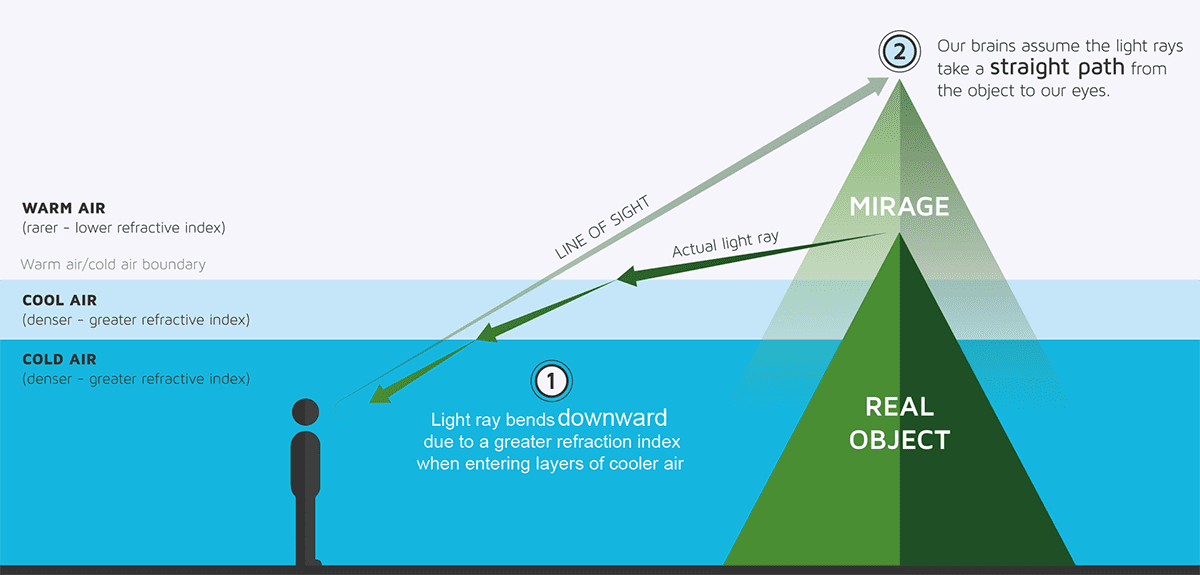Physicists will find it shocking, but there are plenty of people around the world who genuinely believe the Earth is flat. Rachel Brazil explores why such views are increasingly taking hold and how the physics community should best respond

In 2017 the US rapper B.o.B (real name Bobby Ray Simmons Jr) started a crowd-funding campaign to launch a satellite. The rapper, a vocal proponent of “flat-Earth theory”, wanted to seek evidence that our planet is a disc, not a globe. His aim was to raise $200,000 (later upped to $1m) on the GoFundMe website, with the aim of sending one or more craft into space to help him “find the curve” – the term that “flat-Earthers” use to describe the edge of our supposed disc-shaped planet.
The rapper’s quest may seem like a joke or publicity stunt. Indeed, there’s currently no evidence that B.o.B raised much money or got anywhere near his goal. However, in the last few years there has been an alarming rise in the number of people who, like B.o.B, believe in flat-Earth theories. There’s now an annual flat-Earth conference in the US – the most recent of which was attended by more than 600 people – while YouTube is full of videos purporting to provide evidence that the Earth is flat.
Physicists may mock the notion of a flat Earth, but the idea is gaining traction, particularly among people susceptible to other conspiracy theories. “They actually really do believe it,” says Lee McIntyre, a philosopher from Boston University and an expert in the phenomenon of science denial, whose books include Respecting Truth: Wilful Ignorance in the Internet Age (Routledge, 2015). McIntyre knows first-hand how sincerely flat-Earthers hold their views: he attended the 2018 Flat Earth International Conference in Denver, Colorado.
Asheley Landrum, a psychologist from Texas Tech University who was also at the Denver meeting, agrees that flat-Earthers are genuine, and not goofing around. “If they were [trolling], they are very good actors,” she says. “We talked to more than 90 members of the flat-Earth community and they’re all very sincere in their beliefs”. Lectures at the Denver event included “Talking to your family and friends about flat Earth”, “NASA and other space lies” and “14+ ways the Bible says flat Earth”.
Flat-Earth ideas are based on basic scientific misunderstandings that can be easily refuted. For most people, even those who have no physics background, the evidence for a spherical Earth is obvious. So we need to ask ourselves why these ideas still persist in the 21st century and, perhaps more importantly for the physics community: how exactly should we respond?
A circular history
The idea that the Earth is a sphere was all but settled by ancient Greek philosophers such as Aristotle (384–322 BC), who obtained empirical evidence after travelling to Egypt and seeing new constellations of stars. Eratosthenes, in the third century BC, became the first person to calculate the circumference of the Earth. Islamic scholars made further advanced measurements from about the 9th century AD onwards, while European navigators circled the Earth in the 16th century. Images from space were final proof, if any were needed.
Today’s flat-Earth believers are not, though, the first to doubt what seems unquestionable. The notion of a flat Earth initially resurfaced in the 1800s as a backlash to scientific progress, especially among those who wished to return to biblical literalism. Perhaps the most famous proponent was the British writer Samuel Rowbotham (1816–1884). He proposed the Earth is a flat immovable disc, centred at the North Pole, with Antarctica replaced by an ice wall at the disc’s outer boundary.
The International Flat Earth Research Society, which was set up in 1956 by Samuel Shenton, a signwriter living in Dover, UK, was regarded by many people as merely a symbol of British eccentricity – amusing and of little consequence. But in the early 2000s, with the Internet now a well-established vehicle for off-beat views, the idea began to bubble up again, mostly in the US. Discussions sprouted in online forums, the Flat Earth Society was relaunched in October 2009 and the annual flat-Earth conference began in earnest.

As with any fringe movement there are disagreements and several different flat-Earth models exist to choose from. Some models propose that the Earth’s edges are surrounded by a wall of ice holding in the oceans. Others suggest our flat planet and its atmosphere are encased in a huge, hemispherical snow globe from which nothing can fall off the edges. To account for night and day, most flat-Earthers think the Sun moves in circles around the North Pole, with its light acting like a spotlight. The most recent “US model”, for example, suggests that the Sun and Moon are 50 km in diameter and circle the disc-shaped Earth at a height of 5500 km, with the stars above this on a rotating dome. Many flat-Earthers also reject gravity, with the “UK model” suggesting that the disc is itself accelerating up at 9.8 m/s2 to give the illusion of gravity.
Physicists will scoff at these ideas, but the worrying thing is that they are spreading rapidly and gaining proponents outside America too. “While they may not be as many [in Europe], they are as loud as their colleagues in the US,” says Jan Slegr, a physicist from the University of Hradec Králové in the Czech Republic, who in 2018 co-authored a paper outlining ways for teachers and others to confront outlandish flat-Earth ideas with physics (Phys. Educ. 53 045014).
Such efforts are important. Alarming polling data by the firm Datafolha, for example, indicate that 7% of the Brazilian population – some 11 million people – believe that the Earth is flat. This shocking number has been attributed to a resurgent evangelical Christian church, but there are also signs that religious fundamentalism is spreading these ideas in Islamic countries too. In 2017 the website Jeune-Afrique reported that a geology student in Tunisia was intending to submit a PhD defending her work on a flat-Earth model.
Conspiracy mentality
It would be easy to dismiss flat-Earthers as simply being misguided due to a lack of education. While there are indications that those susceptible to such views have low levels of scientific literacy, Landrum at Texas Tech says that flat-Earthers aren’t necessarily people who don’t believe in science. “It’s not really an education thing,” she says. “It really is about distrusting authorities and institutions. [It] seems to be based on both a conspiracy mentality and a deeply held belief that looks a lot like religiosity but isn’t necessarily specifically tied to a religion”.
Landrum thinks this conspiracy mentality is linked to science denial and a susceptibility to believing deceptive claims on social media (Politics and the Life Sciences 38 193). No longer the domain of a “foil-hat-wearing fringe”, she believes those with a conspiracy mentality have lost the ability to judge when to trust and when to be a sceptic. Their lack of trust in authority includes not just scientists but scientific bodies such as NASA, all of whom (they think) are part of a massive conspiracy to prevent the flat-Earth truth being revealed. “[They] view the world through this really dark filter where [they] assume that all authorities and institutions and corporations are just there to exploit you.”
McIntyre adds that the flat-Earthers he interacted with each believed a selection of conspiracy theories, including that governments control the weather and that chem-trails from aeroplanes consist of chemical or biological agents. “The only one I found that they all believed,” he says, “was that we hadn’t gone to the Moon. If you offer them back evidence, like the view of the Earth from the Moon, they say it’s fake.” Indeed, many flat-Earthers are more invested in the idea of a conspiracy than in providing a workable model of a flat Earth.

Why do people still believe in conspiracy theories?
Nikk Effingham, a philosopher at the University of Birmingham in the UK who has met flat-Earthers at a London meet-up, says that we often don’t recognize the extent to which confidence in authority shapes our beliefs. “When we try and prove something like the Earth being round, because it’s a belief that we are so sure of, we under-play the justified role of authority in that,” he says. Most people are therefore comfortable accepting the world is a globe, even if they can’t immediately recount the scientific evidence.
Flat-Earthers seem to have a very low standard of evidence for what they want to believe but an impossibly high standard of evidence for what they don’t want to believe
Lee McIntyre, Boston University
But that’s not the case for those mired in a conspiracy mentality. What’s also clear is that the rise in flat-Earth beliefs has been fuelled by the Internet and YouTube videos in particular. “Almost everybody that we spoke to said that either they were directly exposed to flat Earth on YouTube or they were exposed to it via a family member who was exposed to it on YouTube,” says Landrum. Flat-Earth videos often present numerous arguments in rapid succession with what Landrum dubs “an illusion of fluency”.
Key to the videos’ success has also been the algorithms that serve them up to viewers of other conspiracy-related content. “The algorithms facilitate the normalizing of conspiracies and the feeling of a consensus within your community,” explains Landrum. “Flat Earth is just another example of that.” In 2019 YouTube did acknowledge the problem and said it would be tweaking its algorithm to reduce its recommendations of conspiracy-theory videos. But the fact remains that the videos are still on its platform.
Proving the Earth isn’t flat
It was McIntyre’s work on science denial that led him to the 2018 flat-Earth conference in Denver, where delegates spent time discussing the “evidence” and finer details of their theory as well as the supposed conspiracy that flat-Earthers believe is shielding their ideas from the wider public. “I thought that if I could understand how to push back against flat-Earthers, I could use the same techniques to fight back against climate-change deniers and anti-vaxxers,” he says. After all, their ideas are all generally based on fallacies and misunderstanding of science. “Some of the flat-Earthers know enough physics to throw around the vocabulary, but they don’t actually understand enough physics to be compelled by the truth.”

But even without the visual confirmation of pictures taken from space, many of the arguments used by flat-Earth proponents can be easily dismissed with trigonometry or basic physical laws. A good place to start is with a Foucault’s pendulum, the device named after the French physicist Léon Foucault, who in 1851 famously hung a heavy 28 kg brass bob from a 67 m chain in the Panthéon in Paris. Such a pendulum, which can swing in any plane, changes direction during the course of a day, yielding direct evidence of the Earth’s rotation. (Though as Slegr points out, that hasn’t stopped some flat-Earthers claiming that all Foucault pendulums are fraudulent and that museums use magnetic coils to turn the plane of the pendulum’s rotation to make the Earth seem to rotate.)
Another phenomenon that proves the Earth is a spinning globe is the Coriolis force, which acts perpendicular to the direction of motion of a spinning mass. This force leads to cylones swirling clockwise in the southern hemisphere and counterclockwise in the northern hemisphere; through the direction of winds, it also impacts ocean currents. Long-range military snipers even have to make allowance for deflections caused by the Coriolis effect. Indeed, as Slegr points out, getting physics students to explain the evidence for a spherical spinning Earth is a great critical-thinking exercise.
But that deep critical thinking is what’s often missing among flat-Earthers. Consider photos of distant skylines, which are often wheeled out as “proof” that the Earth is flat. In his interactions with flat-Earth theorists, McIntyre was commonly shown a picture of Chicago, taken from Lake Michigan, in which the city’s skyscrapers are clearly visible despite being viewed from a distance of 100 km out. “Given the curvature of the Earth, you shouldn’t [in principle] be able to see the skyline of the city from that far out,” he says.
The reason the buildings are visible, as McIntyre knows, lies in the fact that air directly above the water’s surface is colder than the air higher up. This inverse temperature gradient means that light rays refract toward the colder, denser air, allowing an image of the reflected skyline, formed on the water below the horizon, to appear almost hovering above the horizon (figure 1). This notion can easily be verified by taking a photo even further away, where the “superior mirage” will disappear.
1 Why distant skyscrapers are visible despite the curvature of the Earth
This photo was taken from Mount Baldy in Indiana Dunes National Park on the south-east coast of Lake Michigan, roughly 60 km across the water from the city of Chicago, which lies on the opposite bank. At that distance, Chicago’s skyline should not be visible as the curvature of the Earth takes it beyond the horizon. The fact that the buildings are visible is in fact simply a mirage. Mirages are usually created when a cold, dense layer of air sits above a layer of warmer, less dense air, for example when the Sun beats down on a black road on a hot summer’s day. The warm ground heats the bottom few centimetres of air, refracting sunlight up to your eyes to create an “inferior mirage”. But if a layer of warm air sits above your line of sight, with a cool layer beneath, you get a “superior mirage”. Light bends down towards the denser air, but because our eyes assume the light has travelled in a straight line, the object appears higher than it is. The effect also explains why a far-off ship can be seen even though it might have dipped below the horizon. It can even make distant boats appear to float in the air.

But, as McIntyre found, this type of reasoning is unlikely to convince flat-Earthers. “They seem to have a very low standard of evidence for what they want to believe but an impossibly high standard of evidence for what they don’t want to believe.” One of their key experimental tools is a Nikon P900 camera with a ×83 optical zoom, in which flat-Earthers place an almost religious faith. Able to capture details not visible to the naked eye, they hope to use it to show that objects don’t disappear over the horizon but come back into view when examined at high enough resolution.
McIntyre described his frustrations with flat-Earthers in a paper last year in the American Journal of Physics (87 694), in which he challenged physicists to come up with simple, straightforward answers to refute the “evidence” for a flat Earth that could be understood by a general audience. Someone who rose to the bait was retired physicist Bruce Sherwood, who realized that “just citing the scientific facts is not going to convince anybody”. Instead, given that flat-Earthers place so much emphasis on naked-eye observations, he and colleague Derek Roff decided to create a navigable 3D computer simulation of a flat Earth to see how well it could replicate what we see.
Based on the US version of the flat-Earth model, it allows anyone to virtually roam a flat world. “Walking round in it, there were many things that show tremendous discrepancies,” says Sherwood. One of the major problems is the size and brightness of the Sun. In the flat-Earth model this varies by more than a factor of two from sunrise to midday, something we obviously do not see. The night sky also differs. In the northern hemisphere we see constellations rising in the east and arcing across the sky but in the flat-Earth model they would just circle at a constant height. “What [Sherwood] has created is something that’s much harder for [flat-Earth proponents] to laugh off, because it takes their own views seriously, [and] traces out the consequences,” says McIntyre. “I think that on this basis, other physicists can go out and help to push.”
Dangerous liaisons
From McIntyre’s perspective, flat-Earth conspiracies are a danger and need confronting. “Maybe 10 or 20 years ago, I would have said, just laugh at them, how much traction are they going to get? I no longer feel that way.” If these ideas are not challenged, he fears that as with supporters of “intelligent design”, proponents of a flat Earth will start running for US school boards, looking to push their ideas into the US education system. “The sort of reasoning that they use is infectious and if you don’t push back against them, it just gets worse and they’re able to recruit new members,” he warns.

A flat-Earth fight, an inconsistent Hubble constant, and carbon atoms at a graphene ‘watering hole’
But Effingham, who has also interacted with flat-Earthers on Facebook, wonders if physics is the place to start combating these conspiracy-based ideas. “I’m not saying that the perfect formula doesn’t have some kind of physics argument in it, but just turning on a YouTube video of physics lectures is not going to do it.” Instead, Effingham has tried to get flat-Earthers to understand that, by watching YouTube videos, they too are slavishly following an authority – not a scientific authority, but the authority of whoever is proposing the conspiracy theories they subscribe to.
Effingham also tries to point out their inconsistencies. “Every position they took required a different view of the conspiracy, and required the conspiracy to be bigger or smaller, and it was impossible to get a consistent conspiracy going that explained everything.” McIntyre, for example, recalls asking one flat-Earther why planes flying over Antarctica from, say, Chile to New Zealand don’t have to refuel, which they’d have to if the continent were (as they believe) an ice wall tens of thousands of kilometres long. He was simply told that planes can fly on one tank of fuel and refuelling planes could just be a giant hoax to stop us realizing that the Earth is flat.

Landrum agrees the underlying problem is one of trust rather than physics. “We really should figure out as a scientific community, and as a society as a whole, how we can start building back trust in our organizations and institutions.” And she feels we need to do this face-to-face. “I don’t mean go yell at them on Twitter – that’s not engaging.” It’s also vital, she says, for scientists not to patronize flat-Earthers but to take questions seriously. That may seem like an excruciatingly painful process, but a necessary one, for people to gain trust in science as an institution again.
A level of sustained personal engagement can change minds. “It does work to push back against science deniers,” argues McIntyre, pointing to current NASA boss Jim Bridenstine. He was appointed by Donald Trump in 2018 and was known to have disputed climate change. “[But] once [he] became head of NASA, within a matter of two months or so, he changed his mind on climate change, and publicly said, ‘I was wrong’,” says McIntyre. The difference was that the evidence was presented to him by scientists he had grown to trust.
Oddly, Landrum says that many flat-Earthers may distrust scientists, but they are not against the scientific method. “The majority of them put a lot of faith, for lack of a better word, in science. There’s a lot of curiosity and a lot of scepticism and a lot of the really good qualities that make scientists.” But while the spirit of experimentation may be there, flat-Earthers are not always prepared to change their minds when their experiments fail. And that’s why McIntrye hopes some physicists might go with him to future flat-Earth conferences.
“I think that physicists need to be more involved,” he says. “There’s really no excuse for us to just sit back and laugh at them. Because while we’re laughing, they are recruiting people to believe these crazy things.”




